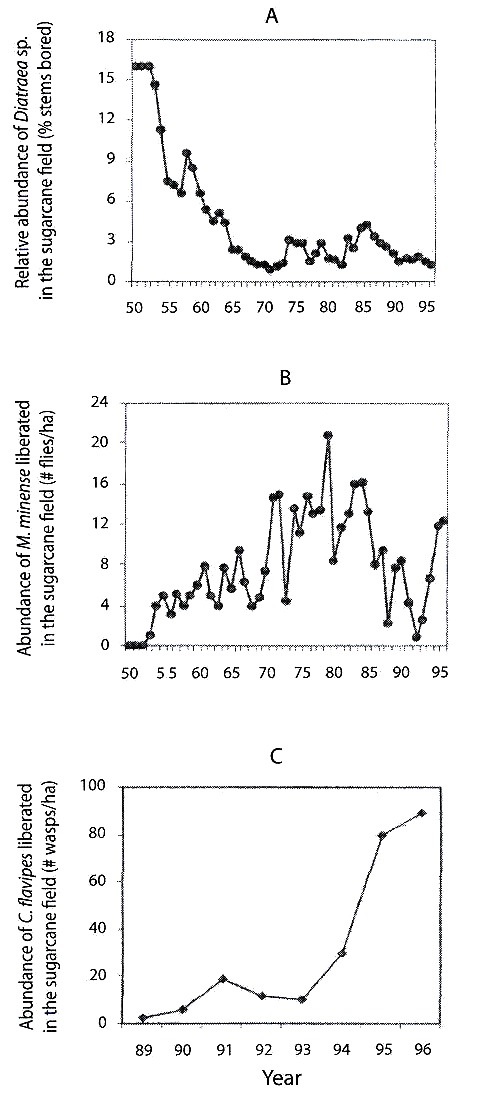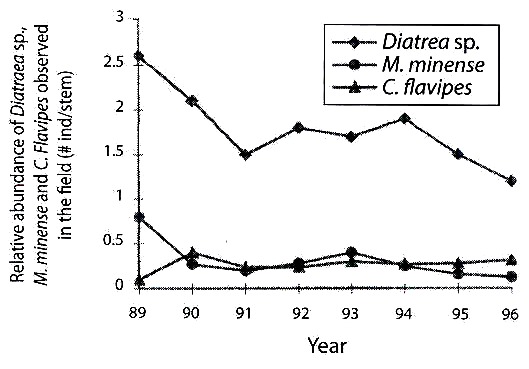Services on Demand
Journal
Article
Indicators
-
 Cited by SciELO
Cited by SciELO -
 Access statistics
Access statistics
Related links
-
 Similars in
SciELO
Similars in
SciELO  uBio
uBio
Share
Revista de Biología Tropical
On-line version ISSN 0034-7744Print version ISSN 0034-7744
Rev. biol. trop vol.55 n.2 San José Jun. 2007
Biological control of Diatraea spp. (Lepidoptera: Pyralidae) in sugarcane crops in Central Venezuela
Enrique H. Weir L.1,3, Williams Contreras2 & Karine Gil de Weir1,3
1 The Platte River Whooping Crane Trust Inc. 6611 W. Whooping Crane Dr. Wood River, NE-68883, Nebraska, USA; henryweirl@msn.com; EWeir@whoopingcrane.org. Fax +1-308-384-7209
2 Central El Palmar, Laboratorio de Entomología, Hacienda Santa Teresa, El Consejo, Edo. Aragua, Venezuela.
3 The Beijer International Institute, The Royal Swedish Academy of Sciences, Lillafrescativågen 4, SE 10405, Stockholm, Sweden.
Received 11-X-2006. Corrected 15-XI-2006. Accepted 28-II-2007.
Abstract: In 1990-1996, we evaluated the relative importance of the Amazonian fly (Metagonystilum minense) and the wasp (Cotesia flavipes), in sugarcane crops, in Central Venezuela. We observed a significant decrease in relative abundance of Diatraea spp. when the Amazon fly abundance increased but not with the wasp abundance. Diatraea spp. abundance in presence of both parasitoids was similar to its abundance throughout the last 45 years, when only inundations of M. minense occurred. However a net effect by using both parasitoids was not evident. M. minense is probably the stronger pest control, because its more efficient in its host searching than C. flavipes and is better as competitor than the wasp. Rev. Biol. Trop. 55 (2): 655-658. Epub 2007 June, 29.
Key words: Metagonystilum minense, Cotesia flavipes, parasitoid, Diatraea, sugarcane.
Flooding agroecosystems with parasitoid insects is sometimes very effective in lowering the abundance of crop pest insects (Knipling and McGuire 1968, Knipling 1970, 1972 Knipling and Gilmore 1971). Thus, parasitoids are commonly reared in laboratories and periodically liberated in high-density populations crop pests (Barclay et al. 1985). The effectiveness of this biological control technique may be improved by adjusting parasitic inundation rates, until the pest population reaches a very low level (Barclay et al. 1985), and by evaluating the stability of parasitic-host system after inundation stops.
The purpose of this study is to evaluate the role of two parasitic species, the Amazonian fly Metagonystilum minense Myers (Diptera: Tachinidae), and the wasp Cotesia flavipes Cameron (Hymenoptera: Braconidae), in regulating sugarcane borers Diatraea saccharalis Fabricius, and Diatraea rosa Heinr (Lepidoptera: Pyralidae) in sugarcane crops in Central Venezuela.
Materials and methods
To determine the relative abundance of as biological control agents of lepidopterous Diatraea spp., M. minense and C. flavipes, we sampled sugarcane harvests yearly, from 1990 to 1996, in Carabobo and Aragua States, Central Venezuela. During each harvest, we counted the number of stem holes, larvae and pupae of Diatraea spp., and pupae of M. minense and C. flavipes on 100 randomly selected sugarcane stems from each of 100, one ha plots (total=10 000 sterns).
These methods employed to estimate pop- ulation were similar enough to those used 1950-1989. Proportions of parasitized and non- parasitized Diatraea spp. were correlated with the abundance of M. minense and C. flavi pes reared in the laboratory, and liberated the farms. Laboratory work was done at the Entomology Laboratory of Santa Teresa Farm, El Consejo, Aragua State.
Stems were dissected in the laboratory to extract Diatraea larvae or pupae, and M. minense and C. flavipes pupae. Each Diatraea larva was placed in a vial and given a corn diet. Food was replaced every two days. Larvae were maintained in vials to molting pupae or to emergence of the parasitoid pupae. Diatraea spp., M. minense and C. flavipes pupae were placed in a Petri dish with absorbent paper.
We performed Kolmogorov-Smirnov and Schefee-Box tests to evaluate normality and homogeneity of variance (Sokal and Rohlf 1995), a parametric analysis of variance when was homogeneous (Sokal and Rohlf 1995), and Kruskal-Wallis test when variance was not homogeneous (Conover 1980).
Results
The relative abundance of Diatraea spp. in sugarcane crops and proportions/ha, of laboratory reared M. minense and C. flavipes, are shown in Figure 1. The impact of mass liberations of these parasitoids on the sugarcane borer population has been important, particularly for M. minense. M. minense has controlled the pests for 50 years with a mean relative abundance range of 0.9 to 4.2 %. Changes in Diatraea spp. population levels showed a significant relationship with M. minense released between 1950 to 1989 (F=99.9, α=0.0001).
A. Relative abundance of Diatraea sp. (estimated by the percent of
stems bored). B y C. Shows the abundace of M. minese y C. flavipes
espectively, liberated in sugarcane fields.
During the last six years of biological control (Fig. 2), changes in Diatraea spp. population density showed a significant relationship with M. minese in this period (F=6.17, α=0.05), but the relationship with C. flavipes was unsignificant (F=2.99, ns). However, the parasitization frequency of Diatraea hosts by C. flavipes was similar to that of M. minense, suggesting that C. flavipes is less efficient than M. minense as a parasitoid, because ten times more C. flavipes must be liberated to equal the effect produced by M. minense.
(porportion of hosts parasitized) obtained from sugarcane stem samples collected ramdomly
durig harvests.
Discussion
For six years, biological control by both M. minense and C. flavipes has used to control Diatraea spp. populations in sugarcane crops in Venezuela. A net effect by using both parasitoids is not evident. The recent trend of Diatraea abundance in presence of both parasitoids is similar to its abundance throughout the last 45 years, when only inundations of M. minense occurred (Fig. 1). However, M. minense probably has had a stronger effect as control agent because is more efficient as parasitoid (Data of Central El Palmar), and better competitor than C. flavipes (Weir and Sagarzazu 1998).
A reduction in Diatraea spp. abundance to lower levels by the parasitoids and partial or total parasitoid extinction may be a result of artificial inundation practices of both parasitoid species (Box 1956, this study). The final balance is an unstable interaction where parasitoid extinction occurs in many patches of sugarcane crops because of these low levels and to the intra and interspecific superparasitism caused by inundation practices (Ferrer et al. 1990, Weir 1991, Weir and Sagarzazu 1998). At present, recurrent inundation of parasitoids has avoided a population increase of Diatraea to epidemic levels in Venezuela (Ferrer et al. 1990, Micale 1995), Colombia (Gaviria 1990) and Brazil (Botelho et al. 1980). Regulation of artificial production of parasitoids, as well as parasitoid release in sugarcane crops, might avoid the intraspecific and interspecific superparasitism and stabilize parasitoid-host interactions. This action would allow a reduction of parasitoids released in sugarcane crops.
Acknowledgments
This research was supported by the entomology Laboratory of Santa Teresa Farm. We thank Roque Morejon for his assistance in this study and Ivan Penzo and Clark Casler for reviewing and improving the manuscript.
Resumen
Entre los años 1990-1996, se evaluó la importancia de la mosca amazónica (Melagonystilum minense) y de la avispa (Cotesia flavipes) como controles biológicos de los perforadores de la caña de azúcar (Diatraea saccharalis y Diatraea rosa) en el centro de Venezuela. Durante el período de la zafra, seleccionamos aleatoriamente tallos de caña de azúcar que fueron abiertos para observar el número de perforaciones, hospedadores, proporción de hospedadores parasitados, proporción de hospedadores parasitados por la mosca amazónica o por la avispa. Como consecuencia de las periódicas liberaciones de las moscas y las avispas criadas en el laboratorio, observamos una disminución pronunciada de la abundancia relativa de Diatraea spp., pero no se obtuvo un efecto evidente de utilizar ambos parasitoides. La abundancia de Diatraea spp. en presencia de ambos parasitoides fue similar a la observada durante los 45 años en que se utilizó únicamente M. minense como control biológico. Sin embargo, M. minense probablemente sea el principal control biológico de esta plaga por ser más eficiente en la búsqueda de la misma y por ser un competidor más fuerte que C. flavipes.
Palabras clave: Metagonystilum minense, Cotesia flavipes, parasitoide, Diatraea, caña de azúcar.
References
Barclay, H.J., I.S. Otvos & A.J. Thomson. 1985. Models of periodic inundation of parasitoids for pest control. Can. Ent. 117: 705-716. [ Links ]
Botelho, P.S.M., N. Macedoy & A.C. Mendes. 1980. Aspects of the population dynamics of Apanteles flavipes (Cameron) and support capacity of its host Diatraea saccharalis (Fabr). Proc. Congr. Int. Soc. Sugarcane Tech. Manila: 1736-1745. [ Links ]
Box, H.H. 1956. The biological control of moth-borers (Diatraea) in Venezuela. Battle against Venezuelas cañe borer. Preliminary investígations and the launching of a general campaign. Sugar: 25-30. [ Links ]
Conover, W.J. 1980. Practical nonparametric statistics. Texas Tech University. Wiley, New York, USA. 493 p. [ Links ]
Ferrer, F., E. Guedez & L. Proano. 1990. El efecto del control biológico de Cotesia flavipes (Hym: Brachonidae) sobre Diatraea spp. (Lep: Pyralidae) en el área de influencia de la azucarera Río Turbio, durante los años 1986-1990, p. 1-10. In Memorias III Congreso Sociedad Colombiana de Técnicos de la Caña de Azúcar (Tecnicaña), Cali, Colombia. [ Links ]
Gaviria, J.D. 1990. El control biológico de los insectos plaga de la caña de azúcar en Colombia, p. 201-227. In Memorias III Congreso Sociedad Colombiana de Técnicos de la Caña de Azúcar (Tecnicaña), Cali, Colombia. [ Links ]
Knipling, E.F. 1970. Influence of host density on the ability of selective parasites to manage insect populations. Proc. Tall Timbers Conf. Ecol. Anim. Control Habitat Manage 2: 3-21. [ Links ]
Knipling, E.F. 1972. Simulated population models to appraise the potential for suppressing sugarcane borer populations by strategic releases of the parasite Lixophaga diatraeae. Environ. Ent. 1: 1-6. [ Links ]
Knipling, E.F. & J.E. Gilmore. 1971. Population density relationships between hymenopterous parasites and their aphid hosts - A theoretical study. USDA Tech. Bull. 1428-1462. [ Links ]
Knipling, E.F. & J.U. McGuire. 1968. Population models to appraise the limitations and potentialities of Trichogramma in managing host insect populations. USDA Tech. Bull. 1387-1431. [ Links ]
Micale, E. 1995. Programa de manejo integrado de los insectos plagas de la caña de azúcar, p. 1-28. In XIV Congreso Venezolano de Entomología, Barquisimeto, Lara, Venezuela. [ Links ]
Sokal, R.R. & F.J. Rohlf. 1995. Biometry. W.H. Freemand, San Francisco, California, USA. 887 p. [ Links ]
Weir, E.H. 1991. Estudio de la competencia larval y respuestas comportamentales en Metagonystilum minense. Tesis Doctoral, Universidad Simón Bolivar, Caracas, Venezuela. 83 p. [ Links ]
Weir, E.H. & L. Sagarzazu. 1998. Interspecifíc competition between Metagonystilum minense (Diptera: Tachinidae) and Cotesia flavipes (Hymenoptera: Braconidae) parasitoids of sugarcane borers (Diatraea spp., Lepidoptera: Pyralidae). Rev. Biol. Trop. 46: 1135-1139. [ Links ]
















